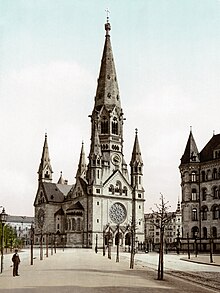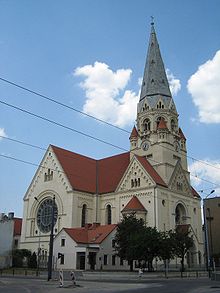Neo-romance


The romanesque , also Romanesque Revival called, is a European art style of the 19th century. Artists, especially architects , used models from the past two millennia - in this case the Romanesque . But there were also neo-Gothic , neo-Renaissance , neo-Baroque and the association of several of these styles in a work (so-called. Eclecticism ), which together in the style of history as historicism are called.
history

In the 1820s, Heinrich Hübsch and Rudolf Wiegmann pioneered the neo-Romanesque in Germany and Europe-wide with fundamental publications , who judged the Romanesque to be more appropriate to their own country. Johann Claudius von Lassaulx and Friedrich von Gärtner were among the first architects of the Neo-Romanesque , whose arched style showed other influences in addition to the Romanesque . Since the art-historical term “Romanesque” did not yet exist at that time, the terms “Byzantine style”, “round arch style” or “early Christian style” were used equally.
The Eisenacher Regulativ published in 1861 allowed the medieval styles of Romanesque and Gothic as a style for Protestant church building in addition to the early Christian basilica. The climax of the neo-Romanesque can be set in 1891 with the Wiesbaden program on Protestant church building. The style extends beyond the end of actual historicism around the turn of the century to the 1920s. The building activity of the neo-Romanesque had its focus on the church. Due to industrialization , there was a rich field of activity in the rapidly growing cities. In the Catholic south of the German-speaking area, however, the style is rarer.
The neo-Romanesque can also be found in secular architecture. Examples of renovations in palaces and fortresses that were equivalent to new buildings are the reconstruction of the Romanesque Wartburg near Eisenach and the imperial palace in Goslar . Neuschwanstein Castle can be considered the most famous neo-Romanesque building , but it has an eclectic interior. When the French origins of the Gothic, which had long been regarded as “old German”, could no longer be disputed, in Wilhelmine Germany the neo-Romanesque was increasingly used as a “real” German style for public secular buildings such as post offices, government buildings or traffic structures. Well-known representatives are z. B. the Prussian government building in Koblenz as well as the train stations Metz-Ville and Worms Hauptbahnhof .
Stylistically, the formal elements of the Romanesque in Western Europe were not only used, but the more splendid forms of the Byzantine style were also used . The construction of the churches did not stick to Romanesque floor plans either, but used the more progressive principles of Gothic, recognizable by the ribbed vaults and the rectangular base of the yokes .
Also in the altar one speaks of neo-Romanesque. However, since no altar structures were used in the Romanesque period, “neo-Romanesque” high altars are often basically neo-Gothic altars that use round arches instead of pointed arches and dispense with pinnacles . The lack of historical models led to the fact that in the historical altar building under the label of "neo-Romanesque" forms and structures were used creatively and corresponding altars often appear more playful than those of the neo-Gothic style.
photos
Holy Cross Church Gladbeck-Butendorf
Nave of the town church Glarus
Herz-Jesu-Kirche in Koblenz, 1900–1903
Interior view of Saint-Pierre-le-Jeune catholique in Strasbourg
Synagogue Cologne , 1895–1899
Garrison Church of St. Martin , Dresden , 1893–1900
Szeged Cathedral , Szeged , 1913–1930
Millennium Church in Timișoara
Catholic parish church Holy Sacrament in Dillingen / Saar
Power station (1905/06) of the Rammelsberg ore mine in Goslar (UNESCO World Heritage Site)
Erlöserkirche (Mirbach) built in 1902
Trinity Church (Boston) , 1872–1877
St. Anthony's Basilica (Rheine) , 1899–1905
Important buildings in the neo-Romanesque style



Germany
- 1828–1832 Unterbarmer main church in Wuppertal , architect Heinrich Hübsch
- 1829–1839 Old Ludwig Church (1839–1944) in Freiburg , architect Heinrich Hübsch
- 1831 Rosenburg in Kessenich (Bonn) , architect Carl Alexander Heideloff
- 1847–1890 Restoration and reconstruction of the Wartburg in Eisenach , architect Hugo von Ritgen
- 1854–1858 West building of the Speyer Cathedral , architect Heinrich Hübsch
- 1868–1879 renovation of the imperial palace in Goslar
- 1869 Start of construction on Neuschwanstein Castle near Füssen (unfinished)
- 1876–1881 Matthäuskirche in Stuttgart , architect Konrad Dollinger
- 1884–1886 St. Cäcilia in Harsum , architect Christoph Hehl
- 1887–1892 St. Anna im Lehel in Munich , architect Gabriel von Seidl
- 1887–1906 Dankwarderode Castle in Braunschweig , architect Ludwig Winter
- 1888–1895 St. Benno in Munich, architect Leonhard Romeis
- 1890–1892 Friedenskirche Stuttgart (preserved tower), architect Konrad Dollinger
- 1891–1895 Kaiser Wilhelm Memorial Church in Charlottenburg (today Berlin), architect Franz Heinrich Schwechten
- 1892–1894 Ringkirche in Wiesbaden , architect Johannes Otzen
- 1893–1898 Church of the Redeemer in Jerusalem , architects Friedrich Adler and Paul Groth
- 1893–1900 Garrison Church of St. Martin in Dresden , architects Hermann Viehweger and William Lossow
- 1894–1897 St. John's Basilica in Berlin , architect August Menken
- 1894–1898 cemetery church in Wuppertal - Elberfeld , architect Johannes Otzen
- 1894–1899 Adalberokirche in Würzburg , architect Franz Josef Ritter von Denzinger
- 1895–1901 St. Maximilian in Munich, architect Heinrich Freiherr v. Schmidt
- 1896–1899 St. Anna in Neuenkirchen , architect Wilhelm Rincklake
- 1897–1900 Anna Church in Zabrze (Hindenburg OS), today Poland, architect Stahl
- 1898–1900 St. Johannes Evangelist Church (Berlin) in Berlin, architect Max Spitta
- 1899 synagogue in Baden-Baden , architect Ludwig Levy
- 1899 Bismarck mausoleum in Friedrichsruh , architect Ferdinand Schorbach
- 1899–1905 St. Antonius Basilica in Rheine , architect Franz Klomp
- 1900–1903 Herz-Jesu-Kirche in Koblenz , architect Ludwig Becker
- 1901 Inauguration of the Christ Church in Altenmünster , architect Rudolf Hofmann
- 1901 Inauguration of St. Elisabeth Church in Stuttgart-West, architect Joseph Cades
- 1901–1906 Berlin Regional Court , architects Hermann Dernburg and Ernst Petersen
- 1902–1903 Church of the Redeemer in Mirbach (Eifel), architects Max Spitta and Franz Schwechten
- 1902–1906 Prussian government building in Koblenz , architect Paul Kieschke
- 1903–1906 Archbishop's Office in Freiburg im Breisgau , architect Raimund Jeblinger
- 1903–1908 Church of the Redeemer in Bad Homburg vor der Höhe , architect Max Spitta
- 1904 (inauguration) of the main train station in Worms , architect Karl Hofmann
- 1905–1906 Martinskirche in Hundersingen (with complete historical furnishings), architect Joseph Cades
- 1905–1908 Luther Church in Chemnitz ( Chemnitz-Lutherviertel ), architect Otto Kuhlmann
- 1905–1913 Posen Residential Palace , architect Franz Schwechten
- 1906–1908 Dreifaltigkeitskirche in Offenburg , architect Johannes Schroth
- 1906–1908 St. Michael Church in Bremen-Vegesack-Grohn , architect Karl Mohrmann
- 1907–1913 Church of the Redeemer in Gerolstein , architect Franz Heinrich Schwechten
- 1908–1910 Sacred Heart Church in Aachen - Burtscheid , architect Josef Kleesattel
- 1910–1913 "Saardom" (Parish Church of the Holy Sacrament) in Dillingen / Saar , architect Peter Marx
- 1911–1915 Mausoleum of Bückeburg Castle , architect Paul Otto August Baumgarten
- 1912–1914 Holy Cross Church in Gladbeck , architect Otto Müller-Jena
China
Denmark
- 1864–1876 Viborg Domkirke
France
- 1884–1886 Versailles synagogue , architect Alfred-Philibert Aldrophe
- 1889–1893 Saint-Pierre-le-Jeune catholique in Strasbourg , architects Skjøld Neckelmann and August Hartel
- 1874–1877 Temple Neuf in Strasbourg, architect Émile Salomon
- 1896–1898 main synagogue in Strasbourg, architect Ludwig Levy
- 1901–1904 Temple Neuf in Metz, architect City Builder Conrad Wahn
- 1905–1908 Metz-Ville station in Metz , architect Jürgen Kröger
Great Britain
- 1873–1881 Natural History Museum in London , architect Alfred Waterhouse
Italy
- 1866–1893 San Tommaso di Canterbury in Rome , architect Virgilio Vespignani
- 1897–1899 Church of the Sacred Heart of Jesus in Bozen , architect Johann Bittner
Croatia
- 1866-1882 Cathedral to Đakovo , architect Carl Roesner and Friedrich von Schmidt
Austria
- 1896–1902 Antonskirche in Vienna , architect Franz von Neumann
- 1898–1913 Church of St. Francis of Assisi (also: Kaiserjubiläumskirche or colloquially Mexican Church ) in Vienna, architect Victor Luntz
- 1904–1906 Herz-Jesu-Kirche in Vienna- Landstrasse , architect Gustav von Neumann
- 1907–1910 parish church Neusimmering in Vienna- Simmering , architect Johann Schneider
- 1908–1909 Hetzendorf parish church in Vienna- Meidling , architects Hubert Gangl and Eugen Ritter von Felgel
- Parish Church of the Holy Cross in Zirl (Tyrol)
Poland
- 1905–1913 Residential palace in Posen , architect Franz Schwechten
- 1909–1928 St. Matthew's Church (św. Mateusz) in Łódź , architects Johannes Wende and Franz Schwechten
Romania
- 1896–1901 Millennium Church in Timișoara , architect Ludwig von Ybl
Switzerland
- 1863–1866 town church in Glarus , architect Ferdinand Stadler
- 1884–1886 Marienkirche in Basel , architect Paul Reber
- 1898–1901 Pauluskirche in Basel , architect Karl Moser
South America
- 1931 (consecration) Catedral Metropolitana de Medellín , Colombia, architect Charles Émile Carré
- La Recoleta, in Arequipa , Peru
Hungary
- 1895–1902 Fisherman's Bastion in Budapest , architect Frigyes Schulek
United States
- 1872–1877 Trinity Church , Boston
- 1930 (completion) St. Bartholomew's Church , New York City , architect Bertram Goodhue
- University of California, Los Angeles
- 1907 (start of construction) neo-Romanesque crypt of the neo-Gothic National Cathedral Washington
See also
literature
- Kathleen Curran: The Romanesque Revival: Religion, Politics, and Transnational Exchange. Pennsylvania State University Press, University Park 2003, ISBN 978-0-271-02215-4 .
- Heinrich Hübsch : In which style should we build? Müller, Karlsruhe 1828. (Reprint: Müller, Karlsruhe 1984, ISBN 3-7880-9695-0 )
- Rudolf Wiegmann: Comments on the font "In which style should we build?" by Heinrich Hübsch . In: Kunstblatt. 10, 1829, pp. 173-174, 177-179 and 181-183.



















